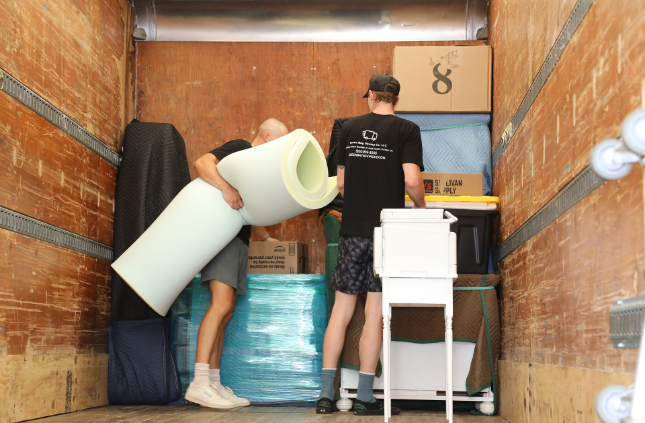If you’ve ever packed a moving truck, ordered flooring, or tried to determine the amount of material needed for a project, you’ve likely encountered the term linear feet. While it may sound technical, it is one of the simplest measurements you can use.
A linear foot is simply a measurement of length helping homeowners, movers, and businesses take accurate measurements without confusion. Whether you’re moving in Wisconsin, repairing flooring, or planning a new installation, learning how to calculate linear feet is essential.
What Is a Linear Foot?
A linear foot is equal to 12 inches in a straight line. It measures length or distance without considering width, height, or depth. For example, a 12-foot-long board equals 12 linear feet, regardless of its width or thickness.
This measurement is different from square feet, which include both length and width, or cubic feet, which measure volume. Linear feet are commonly used to calculate materials such as baseboards, flooring, shelving, or even to estimate truck space during a move. Because linear footage is a one-dimensional measurement, it provides a precise way to calculate the length of items without overcomplicating the process.
Why Linear Feet Matter
Understanding linear footage is important for several reasons:
- Truck Space Allocation – Moving companies often use linear feet to calculate how much space is needed in a truck or trailer.
- Pricing Transparency – Estimates based on linear feet give customers clear insight into charges.
- Efficient Installation – Flooring, molding, and baseboards are typically sold per linear foot, ensuring accurate planning.
- Specialty Items – Oversized furniture or appliances may require additional linear footage even if they aren’t wide.
For both residential and commercial projects, accurate linear feet calculations help determine the total length of materials or truck space needed.
Tools to Measure Linear Feet
You don’t need complex equipment to measure linear feet. A few basic tools are enough:
- Tape Measure – Essential for measuring the length or distance of items.
- Laser Measure – Useful for large rooms or long walls, especially when measuring something parallel to the walls or along the longest wall.
- Calculator or Phone App – A conversion calculator or feet calculator can help ensure accurate results when converting inches to feet or when working with multiple measurements.

Step-by-Step Guide: How to Calculate Linear Feet
- Measure the Length
Use a tape measure to measure the length of one item or the total length of a wall. - Ignore Width and Height
Linear feet focus only on length. - Add Measurements Together
If you’re working with multiple items, record each and total the linear footage. - Convert Inches to Feet
Divide inches by 12. For example, 36 inches equals 3 feet. - Apply to Real Examples
- Sofa: 7 feet long
- Dining Table: 6 feet long
- Dresser: 4 feet long
- Total = 17 linear feet
- Sofa: 7 feet long
This method ensures accurate measurements and helps you determine the total linear footage of a space or object.
Linear Feet vs. Square Feet
Many confuse linear feet with square footage of an area. Here’s the difference:
- Linear Feet: One-dimensional measurement used in construction for baseboards, flooring, or shelving.
- Square Feet: A two-dimensional measurement of length × width, often used for calculating the total area of a floor.
When you calculate the square footage, you are measuring the total area, but when you calculate linear feet, you focus on length only.
Common Uses of Linear Feet
Linear feet are commonly used to measure:
- Flooring Installation – Baseboards, tiles, or molding are sold by linear foot.
- Moving & Storage – Some companies charge per linear foot of truck or trailer space.
- Pallets & Materials – Lumber, fencing, and fabric often sell by the linear foot.
- Repairs & Cleaning Projects – Measuring replacement boards, pipes, or trim by linear feet helps calculate the total material needed.
Whether you’re planning and executing your project or estimating a move, linear footage might be the most straightforward measurement to rely on.

Mistakes to Avoid When Calculating Linear Feet
- Mixing Up Square Feet and Linear Feet – Always remember linear means length.
- Not Rounding Up – If you measure 6.8 feet, round up to 7 feet.
- Skipping Large Items – Oversized furniture or appliances can add many linear feet.
- Forgetting Installation or Repair Clearance – Leave extra space to secure items properly.
By following the formula for calculating length and avoiding errors, you’ll achieve precise measurement and accurate results.
Linear Foot vs. Board Feet
A board foot is different from a linear foot. Board feet measure volume in lumber:
- Formula = (Length × Width × Thickness) ÷ 12.
In contrast, linear footage is only about length.
Knowing the difference helps you order the right amount of lumber for construction or installation projects.
Tips to Save Money When Using Linear Feet Calculations
- Declutter Before Moving – Fewer items mean fewer linear feet.
- Disassemble Furniture – Breaking down tables or shelving reduces the total length.
- Stack Efficiently – Group items closely to save space.
- Use a Calculator – A feet calculator or conversion calculator can help you calculate the total correctly.
Whether you’re working with 10 linear feet, 20 linear feet, or even 50 feet, careful planning helps determine how much space and material you truly need.

Conclusion
A linear foot is simply a measurement of length, equal to 1 foot in length or 12 inches. It is commonly used to measure flooring, baseboards, lumber, or truck space during a move. Unlike square footage and cubic measurements, it focuses only on length, making it easy to apply in construction, installation, or moving projects.
By learning how to calculate linear feet, you can determine the amount of material needed, ensure accurate truck estimates, and get accurate results for both home and business projects. Whether you’re handling cleaning, repair, or installation, linear feet calculations simplify planning and ensure you don’t underestimate the total linear footage of a space.














